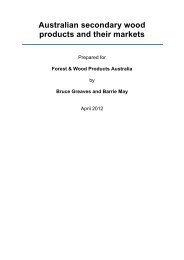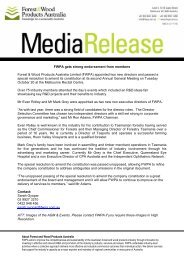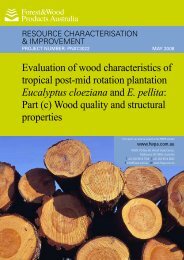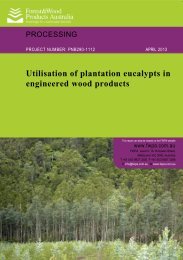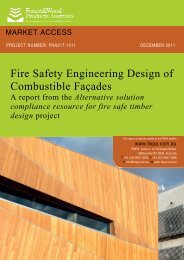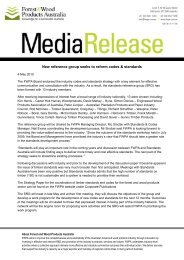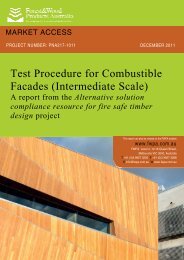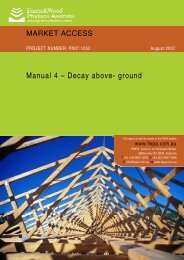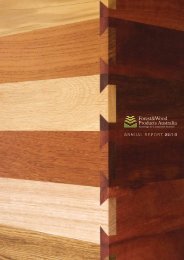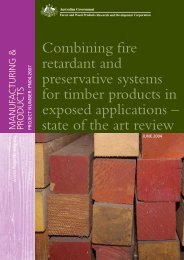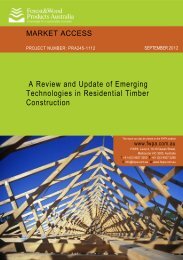guide to the specification, installation and use of preservative treated ...
guide to the specification, installation and use of preservative treated ...
guide to the specification, installation and use of preservative treated ...
Create successful ePaper yourself
Turn your PDF publications into a flip-book with our unique Google optimized e-Paper software.
GUIDE TO THE SPECIFICATION, INSTALLATION<br />
AND USE OF PRESERVATIVE TREATED<br />
ENGINEERED WOOD PRODUCTS<br />
drying in response <strong>to</strong> sunlight, rain, humidity, condensation, temperature <strong>and</strong> airflow. Over time <strong>the</strong><br />
result is mechanical damage <strong>to</strong> <strong>the</strong> wood surface in <strong>the</strong> form <strong>of</strong> checks, cracks, splits, raised grain<br />
<strong>and</strong> loose fibres. Direct erosion <strong>of</strong> <strong>the</strong> wood surface may be expected at rates between 6 <strong>to</strong> 13 mm<br />
per 100 years.<br />
EWPs can particularly suffer from delamination (separation) around <strong>the</strong> glue-lines <strong>of</strong> individual<br />
components, laminates, veneers, str<strong>and</strong>s or particles, resulting in product failure. In addition, EWPs<br />
may suffer from dimensional dis<strong>to</strong>rtion, or movement, due <strong>to</strong> moisture content changes (refer <strong>to</strong><br />
“Moisture affects on stability”).<br />
Degradation <strong>of</strong> EWPs due <strong>to</strong> wea<strong>the</strong>ring can be effectively minimised by <strong>the</strong> application <strong>and</strong><br />
maintenance <strong>of</strong> finish coatings <strong>and</strong> by good architectural detailing (refer <strong>to</strong> “Design <strong>and</strong> <strong>installation</strong>”).<br />
Wood decay<br />
Biodeterioration <strong>of</strong> wood, <strong>and</strong> EWPs which are essentially composed <strong>of</strong> wood, results from attack by<br />
biological organisms under favourable environmental conditions. The broad group <strong>of</strong> fungi which<br />
attack wood cells in <strong>the</strong> timber can be classified as:<br />
Moulds <strong>and</strong> stains (e.g. blue stain) – <strong>the</strong> main effect is on <strong>the</strong> appearance <strong>of</strong> <strong>the</strong> wood,<br />
although blue stain increases permeability <strong>and</strong> reduces impact strength.<br />
Rot (decay) fungi – significantly affect strength <strong>and</strong> stiffness due <strong>to</strong> break down <strong>of</strong> <strong>the</strong> cellular<br />
structure <strong>of</strong> <strong>the</strong> wood.<br />
Four conditions are necessary <strong>to</strong> allow growth <strong>of</strong> all fungi in wood:<br />
Moisture – fungi will become<br />
established when <strong>the</strong> wood<br />
moisture content exceeds<br />
30%. Some fungi continue <strong>to</strong><br />
attack <strong>the</strong> wood at moisture<br />
contents down <strong>to</strong> 20% mc. All<br />
fungal activity ceases below<br />
20% mc.<br />
Oxygen – oxygen is generally<br />
not available at levels that<br />
support most decay fungi in<br />
submerged or fully saturated<br />
wood or where it is well below<br />
ground.<br />
Temperatures between 5˚C<br />
<strong>and</strong> 40˚C – <strong>the</strong> ideal range is<br />
25˚C <strong>to</strong> 30˚C.<br />
Food – unprotected wood<br />
provides a suitable food<br />
source <strong>of</strong> sugars <strong>and</strong><br />
carbohydrates. The sapwood<br />
is particularly susceptible <strong>to</strong><br />
fungi, but can be protected by <strong>preservative</strong> treatment.<br />
Decay <strong>of</strong> un<strong>treated</strong>, non-durable Glulam beams in<br />
full wea<strong>the</strong>r exposure (Brisbane).<br />
(Courtesy Doug Mayes)<br />
Removal <strong>of</strong> one <strong>of</strong> <strong>the</strong> above four conditions will prevent decay. For <strong>the</strong> designer or <strong>use</strong>r <strong>of</strong> EWPs <strong>the</strong><br />
risk <strong>of</strong> decay may be minimised by ei<strong>the</strong>r keeping <strong>the</strong> wood dry (



